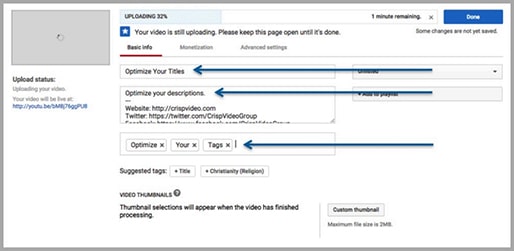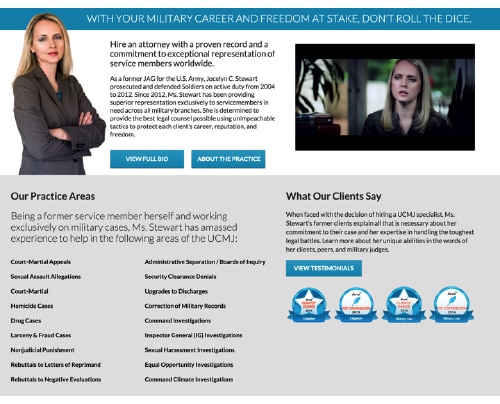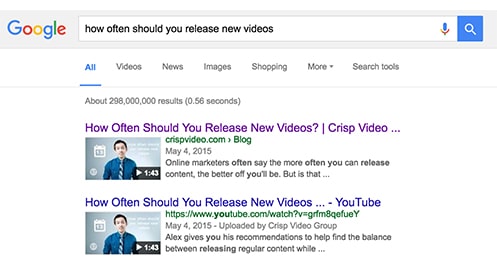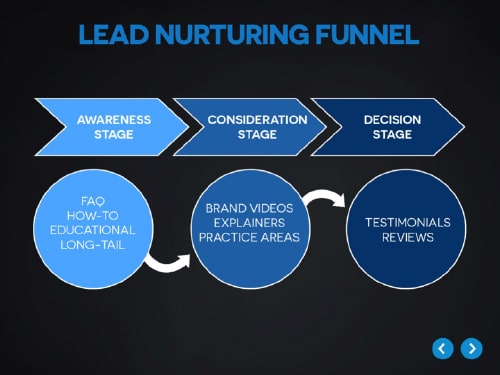Video has become one of the most effective — and flexible — online marketing tools available to lawyers today. Whether you’re looking to stand out from the pack, build client confidence, connect emotionally, or simply attract and convert new viewers into clients, video can help give you a marketing edge. Video can be used for your website, YouTube, social media, television, newsletters — and even as part of your email signature.
Here are five video marketing tips to help beginners and veterans alike:
1. Upload Your Videos to YouTube
This one’s a no-brainer. Regardless of whether you self-host videos on your website or host them through a proprietary platform, you should absolutely upload your videos to YouTube. YouTube is the second-largest search engine on the web and it’s owned by the number one search engine on the web, Google. You can expect to benefit from YouTube’s union with the search engine giant that is Google.
Once you upload your video to YouTube, be sure to optimize your titles, descriptions and tags. This will help prospective clients find your video. Incorporate the following into your titles, descriptions, and tags:
- Your city and practice area (e.g., Seattle Personal Injury Lawyer)
- Your firm’s name
- Your firm’s contact number
- Link to your website (in your description)
- Specify your location (city in your title, city and state in your description)
Another way to get the most out of YouTube is to use the video thumbnail options. In the past, YouTube would generate a random set of thumbnails for your video (which could be out of focus or less than ideal). See the “before and after” images below.
Now, YouTube lets you upload your own thumbnails. This is very important because the thumbnail is often the first thing prospective clients searching for your videos will see. (Or, in the case of your website, this is how the video will show up when it’s embedded). To make the best first impression, make sure that thumbnail is engaging, professional and in alignment with your brand.
2. Embed Videos on Your Website (Correctly)
When you embed your videos on your website, make sure that you place them appropriately within the context of the site, and that you embed them properly.
If you have a brand overview video, place it near the top of the homepage so your visitors don’t have to scroll down to see it. This way they can immediately be introduced to you and your firm. (See the example below of the Law Office of Jocelyn C. Stewart website.)
If you have a video that’s educational in nature or that answers a specific question (e.g., FAQs), it might not belong on the page that provides a broad overview of your services. Use it in a page that contains copy pertaining to the question.
But embedding video the right way goes beyond how it looks. You also want to optimize for search so that your video becomes a tool for driving organic traffic to your website. Instead of using the standard embed code provided by YouTube, consider using Schema markup. Schema markup gives search engines more information about your content, including the duration of your video and a thumbnail image. This helps you rank higher, and may even enable your page to appear twice in search results (see below).
3. Use Videos in Your Blog
Embedding videos in your website’s blog is another great way to reach your audience in an engaging way, and attract inbound leads through organic search results. You may already be providing useful content on your blog, but if it is too text-heavy, you may not hold your audience’s attention — and a high bounce-rate with low time on the site can hurt your search rankings. Follow these steps when creating blog posts that include videos:
- Create a blog post with the same name as your video’s title.
- Embed your video at the top of the blog post.
- Include a transcript of the video in the copy.
- Embed your video using Schema markup.
If you release new blog posts regularly (every other week) over a defined period of time, that tells your audience and search engines that you are a consistent source of valuable content and thought leadership.
Think twice before uploading all of your video content all at once. Doing so can lead to what’s called “subscriber burn” and even hurt your search rankings. YouTube and Google recommend releasing a video once every other week to ensure audience growth and higher SEO scores. Adhering to a consistent rotation when publishing videos will ensure that your audience won’t get subscriber burn.
4. Utilize Facebook
Using videos effectively on Facebook can extend your targeted reach as well. Make sure that you natively upload your video directly to Facebook, though, instead of simply linking to the video you published on YouTube.
Videos uploaded directly to Facebook will begin playback automatically when displayed in the news feed. This is important because you have limited time to engage prospective clients (or get them to stop scrolling through their newsfeed and watch your video). If you link to a YouTube video, people will only see a static thumbnail image of your video as they scroll past it — and most likely they will keep scrolling.
Facebook offers extensive options to market a video to specific audiences, allowing you to segment them by age, gender, occupation, region, household income — the sky’s the limit! Also, if you have an email list (or phone number list) of your ideal clients (i.e., current clients), you can upload that list to Facebook and it will build a similar lookalike audience that you can target in your marketing efforts.
5. Add Video to Email Signatures

Think beyond your own email signature. If you work within a practice group or team, including a video in email signatures can reinforce brand consistency and authority across the firm. Furthermore, recipients who use Gmail will see the video appear within the message!
Again, grabbing your audience quickly and keeping their attention is crucial.
The Lead Nurturing Funnel
All of the items listed above involve lead nurturing. When planning your videos, you want to have a video that engages people in each stage of the process, from the awareness stage to consideration to the decision stage.
- In the awareness stage, provide value-based videos that help people answer questions about your brand.
- In the consideration stage, demonstrate your firm’s unique value proposition, to show what sets you apart from your competition.
- Finally, the decision stage is when you can highlight your actual practice areas with videos that offer client testimonials and reviews.
Creating compelling videos and using them consistently across all the online platforms you use to market your firm will lead to greater exposure for your services.
Learn More at Lawyernomics 2016
“10 Ways to Attract New Clients with Legal Video″ will be Michael Mogill’s topic when he speaks at Avvo’s Lawyernomics 2016 Lawyer Marketing and Business Conference in Las Vegas on April 7-9. Attorney at Work is a Media Sponsor of Lawyernomics 2016.
Illustration ©iStockPhoto.com




























